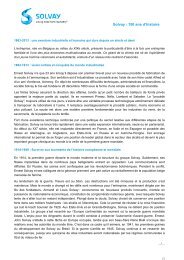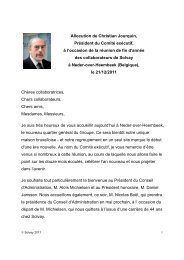Create successful ePaper yourself
Turn your PDF publications into a flip-book with our unique Google optimized e-Paper software.
To manage legal risk <strong>Solvay</strong> maintains in-house legal and intellectual property resources, and relies on additional<br />
external professional resources as appropriate. By doing business, <strong>Solvay</strong> is naturally exposed to disputes and<br />
litigations. Adverse outcome of such disputes or litigations is always possible. The Group is managing this risk<br />
by relying on the internal and external resources and by making appropriate financial provisions.<br />
In the chemicals and plastics industries, technological know-how can remain protected by way of trade secret,<br />
which is often a good substitute for patent protection and <strong>Solvay</strong> is, in many cases, a leader in the technological<br />
know-how for its production processes. However, <strong>Solvay</strong> systematically considers patenting new products and<br />
processes and maintains continuous efforts to preserve its proprietary information.<br />
In respect of political risks, <strong>Solvay</strong>’s actions include risk-sharing with local or institutional partners as well as<br />
insurance solutions.<br />
4. Corporate Governance and Risk attached to Internal Procedures<br />
The risk attached to Internal Procedures is <strong>Solvay</strong>’s exposure to failure to comply with its own Code of Conduct,<br />
policies and processes. Examples of risks are failed Human Resource strategy, failure to integrate an acquired<br />
company, failure to comply with internationally recognized Corporate Governance rules and good practices, etc.<br />
Mitigation efforts<br />
In the field of Corporate Governance, <strong>Solvay</strong> has a comprehensive corporate governance charter, publicly available<br />
on www.solvay.com, and publishes its yearly report on the application of <strong>Solvay</strong>’s Corporate Governance rules.<br />
With respect to behavioral risks, training programs are being widely deployed in order to make managers aware<br />
of the importance of legal and antitrust risks. Training will also be organized to enhance ethical compliance with<br />
<strong>Solvay</strong>’s Code of Conduct. Any violation of the Code will be acted upon.<br />
In 2007 a compliance organization under the leadership of the Group General Counsel was set up to promote<br />
and monitor compliance with the Code of Conduct across the Group. Compliance Officers have been appointed<br />
in all regions. A training course entitled “One Group, One Code, One Path” is being deployed to familiarize<br />
all employees with the Code of Conduct and promote respect of it. Any violation of this code will lead to sanctions<br />
in accordance with prevailing legislation.<br />
<strong>Solvay</strong> reduces the risks linked to Corporate Governance and internal procedures by implementing strict policies<br />
regarding the hiring and training of employees and by making sure the Code of Conduct is enforced rigorously<br />
throughout the organization, in large part by genuinely embedding it in the values of the company.<br />
5. Financial Risk<br />
Financial Risk is <strong>Solvay</strong>’s exposure to foreign-exchange risk, liquidity risk, interest-rate risk, counterparty risk<br />
(credit risk), or failure to fund pension obligations.<br />
• Liquidity Risk relates to <strong>Solvay</strong>’s ability to service and refinance its debt including notes issued and to fund<br />
its operations. This depends on its ability to generate cash from operations.<br />
Mitigation efforts<br />
The Group is recognized as historically having a prudent financial profile, as illustrated by its “mid single A”<br />
rating. In particular credit spreads for ”mid single A” issuers suffer less from deteriorating credit conditions than<br />
those of issuers with weaker ratings. On the one hand, <strong>Solvay</strong> maintains as its objective a net debt to equity<br />
ratio not durably exceeding 45 %. On the other hand, <strong>Solvay</strong>’s liquidity profile is very strong, mainly supported<br />
by significant cash balances and committed bank facilities, including two syndicated loans of EUR 400 and<br />
850 million respectively. The first maturities of <strong>Solvay</strong>’s long-term debt are not until 2011.<br />
• As for Foreign Exchange Risk, <strong>Solvay</strong> is naturally exposed to it as a consequence of its international activities.<br />
In its present structure, the Group’s exposure is mainly associated with the EUR/USD risk, as the Group‘s overall<br />
activities generate a net positive USD flow. Consequently, a depreciation of the USD will generally result in lower<br />
revenues for <strong>Solvay</strong>.<br />
Financial<br />
109<br />
<strong>Solvay</strong> Global Annual Report 2007


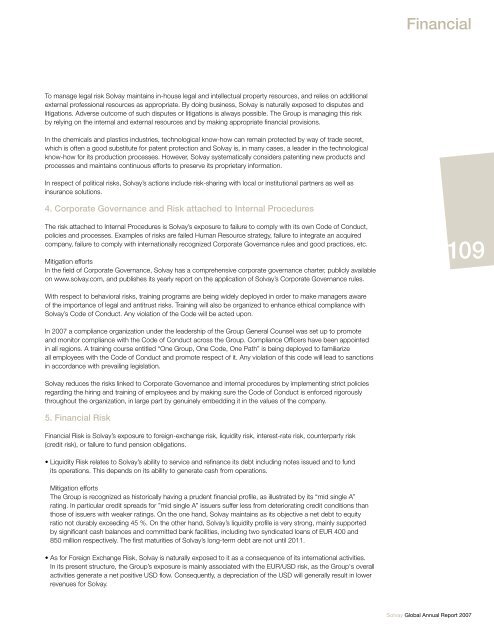
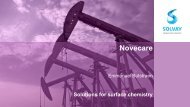
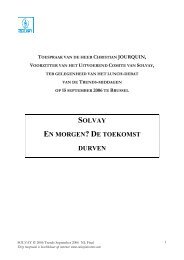
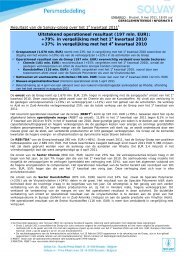

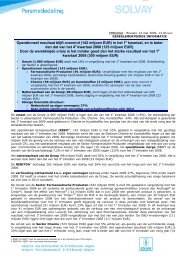
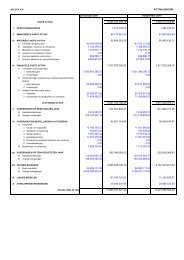


![PROC.1 [LETTRE] - Solvay](https://img.yumpu.com/16585746/1/184x260/proc1-lettre-solvay.jpg?quality=85)
